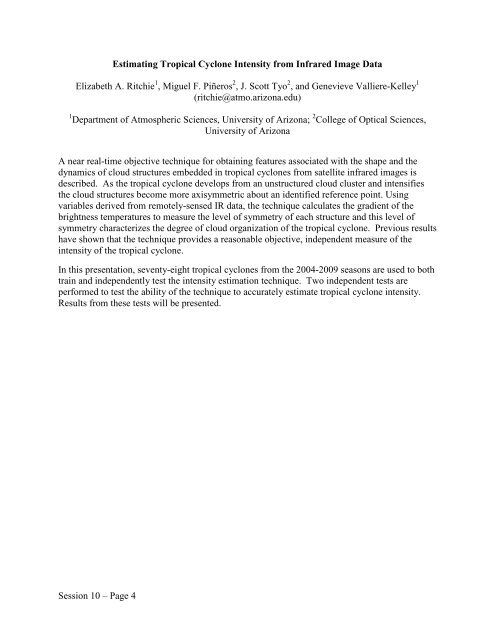65th IHC Booklet/Program (pdf - 4.9MB) - Office of the Federal ...
65th IHC Booklet/Program (pdf - 4.9MB) - Office of the Federal ...
65th IHC Booklet/Program (pdf - 4.9MB) - Office of the Federal ...
You also want an ePaper? Increase the reach of your titles
YUMPU automatically turns print PDFs into web optimized ePapers that Google loves.
Estimating Tropical Cyclone Intensity from Infrared Image Data<br />
Elizabeth A. Ritchie 1 , Miguel F. Piñeros 2 , J. Scott Tyo 2 , and Genevieve Valliere-Kelley 1<br />
(ritchie@atmo.arizona.edu)<br />
1 Department <strong>of</strong> Atmospheric Sciences, University <strong>of</strong> Arizona; 2 College <strong>of</strong> Optical Sciences,<br />
University <strong>of</strong> Arizona<br />
A near real-time objective technique for obtaining features associated with <strong>the</strong> shape and <strong>the</strong><br />
dynamics <strong>of</strong> cloud structures embedded in tropical cyclones from satellite infrared images is<br />
described. As <strong>the</strong> tropical cyclone develops from an unstructured cloud cluster and intensifies<br />
<strong>the</strong> cloud structures become more axisymmetric about an identified reference point. Using<br />
variables derived from remotely-sensed IR data, <strong>the</strong> technique calculates <strong>the</strong> gradient <strong>of</strong> <strong>the</strong><br />
brightness temperatures to measure <strong>the</strong> level <strong>of</strong> symmetry <strong>of</strong> each structure and this level <strong>of</strong><br />
symmetry characterizes <strong>the</strong> degree <strong>of</strong> cloud organization <strong>of</strong> <strong>the</strong> tropical cyclone. Previous results<br />
have shown that <strong>the</strong> technique provides a reasonable objective, independent measure <strong>of</strong> <strong>the</strong><br />
intensity <strong>of</strong> <strong>the</strong> tropical cyclone.<br />
In this presentation, seventy-eight tropical cyclones from <strong>the</strong> 2004-2009 seasons are used to both<br />
train and independently test <strong>the</strong> intensity estimation technique. Two independent tests are<br />
performed to test <strong>the</strong> ability <strong>of</strong> <strong>the</strong> technique to accurately estimate tropical cyclone intensity.<br />
Results from <strong>the</strong>se tests will be presented.<br />
Session 10 – Page 4
















